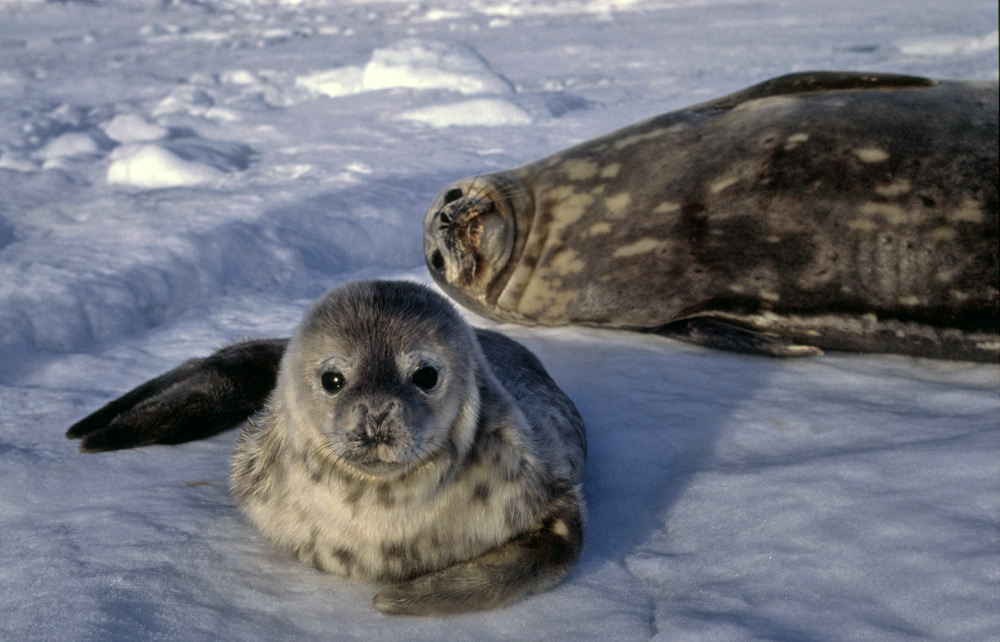Weddell Seals - Leptonychotes wedelli
Facts, Biology and Adaptations
Weddell Seals are animals of the ice, they live and breed further south than any other mammal.
Weddell Seal facts - Basics
Average Weight: 400 - 450 kg / 880 -
990 lb
Average Length: 2,9m - 9.5
ft males / females up to 3.3m - 11ft
Breeding
Season: Pups born from September to November, females
become pregnant again very quickly as the males guard territories
around breathing holes, there is an implantation delay of
2 months and then the female is pregnant for 11 months,
typically 2 pups are produced every 3 years.
Estimated world population: - 500,000 to
1 million. Very difficult to gauge the population size as
the seals are circumpolar and many live in and amongst the
pack ice. They don't form colonies as such other than loose
associations of mothers and pups briefly after birth. The
number of seals at sea during population estimates is a
further unknown.
Feeding & diet:
Mainly fish, especially Notothenids known as "Antarctic
cod", squid and invertebrates (inevitably including krill)
in much lower quantities.
Diving:
Weddell seals are impressive divers, they can reach 600m
in depth and spend as long as 82 minutes, the longest dives
are undertaken when swimming under ice searching for new
breathing holes.
Conservation status:
Least concern. Protected by the Antarctic Treaty
and the Convention for the Conservation of Antarctic Seals.
Distribution: Circumpolar, the most
southerly breeding mammal in the world, as far north as
sub-Antarctic Islands and as far south as 78° in McMurdo
Sound.
Predators: Killer whales,
Weddell seals were taken as one of the main food sources
for sledge dogs when these were used in Antarctica from
1899 to 1994, any local effects of population seem to have
been reversed now.
What are Weddell Seals like?
Weddell seals are animals of the ice. They live further south than any other mammal. Between the end of August and early November in the southern hemisphere spring, the mothers to be haul themselves out of holes in the ice and give birth to their pups.
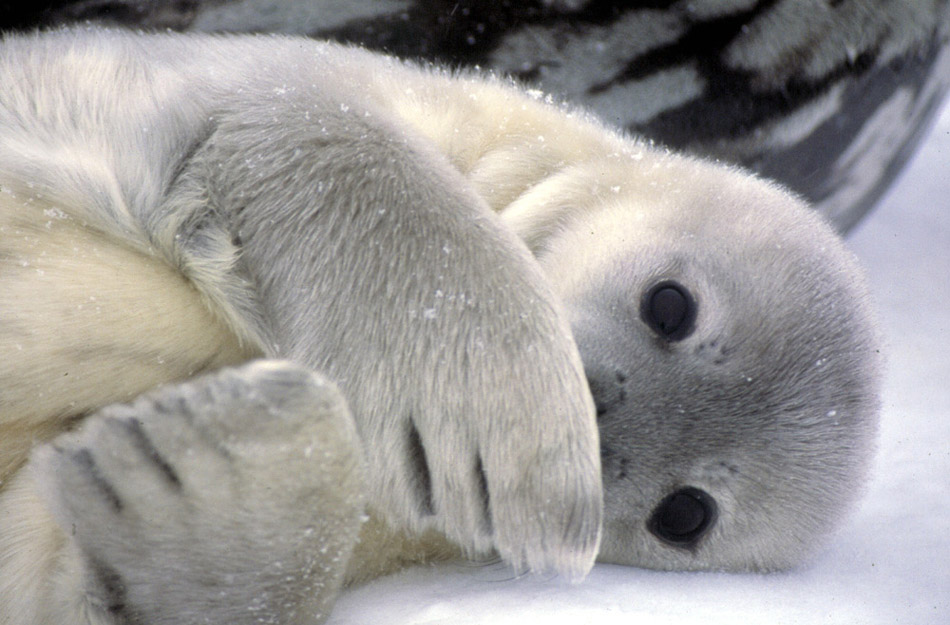
The mother arrives pregnant and with enough resources of blubber and protein to double the 25kg (55lb) birth weight of a pup in 10 days. She doesn't feed for about a month after her pup is born, and goes from an extremely plump barrel shape just before she gives birth, to a skinny shadow of her former self with ribs visible while the pup reverses the process. When born, Weddell seal pups look like unstuffed pajama cases, all skin and flippers and not much content. Over the next few weeks the change in mother and pup is like one balloon deflating and filling up another.
Newly born Weddell seal pups have to be some of the worlds cutest creatures as they flop about the ice in the early days after their birth, not able to co-ordinate their over-sized flippers before they grow into them.
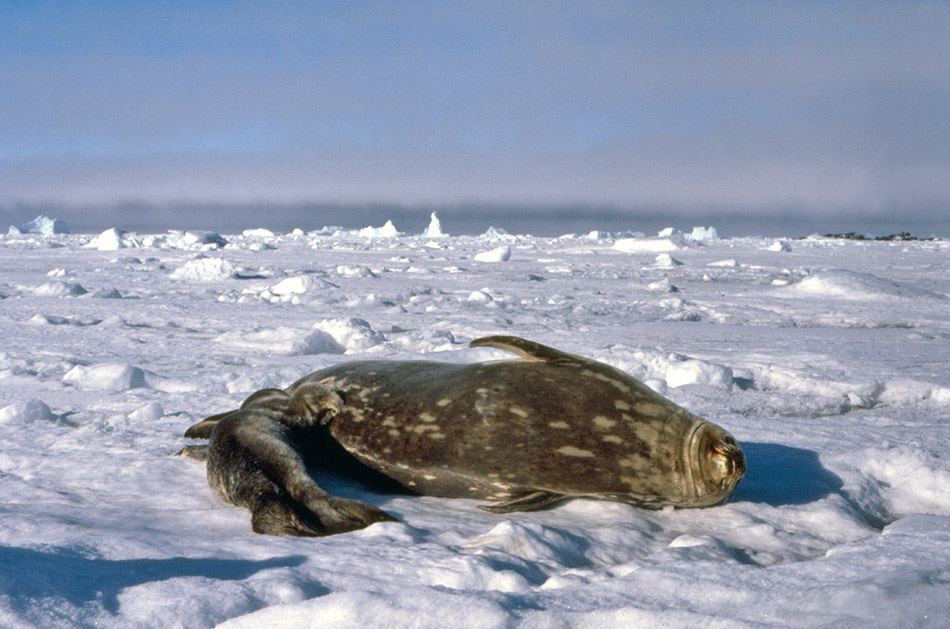
Isn't it difficult for the pups to survive when they're born onto the ice?
Weddell seal milk is one of the richest produced by any mammal. It contains about 60% fat (go and compare that to the label on the milk carton in the fridge) and it is this that is responsible for the rapid weight gain made by pups shortly after birth.The pups are weaned (stop drinking milk and begin eating normal seal food, i.e. fish) at around 7 weeks when they should have reached about 110kg (242lb). When adult, they will weigh up to 450kg (990lb) and be up to 3.3m (11ft) long. Unusually for mammals the males are slightly smaller than the females.
Pups are encouraged into the water very early on by their mothers, perhaps only a week or so after birth. The water is their natural habitat and with their thick protection of blubber is a more comfortable place to be most of the time for these seals than out on the ice where the temperature can be -40° C or less with winds frequently of gale force or greater.

Underwater Life
Weddell seals live on the edge of the ice all year round and dive down beneath it to feed. When underwater there is frequently little light, particularly if there is a layer of snow over the ice which can make it very dark indeed. The seals therefore need good vision to catch their food.
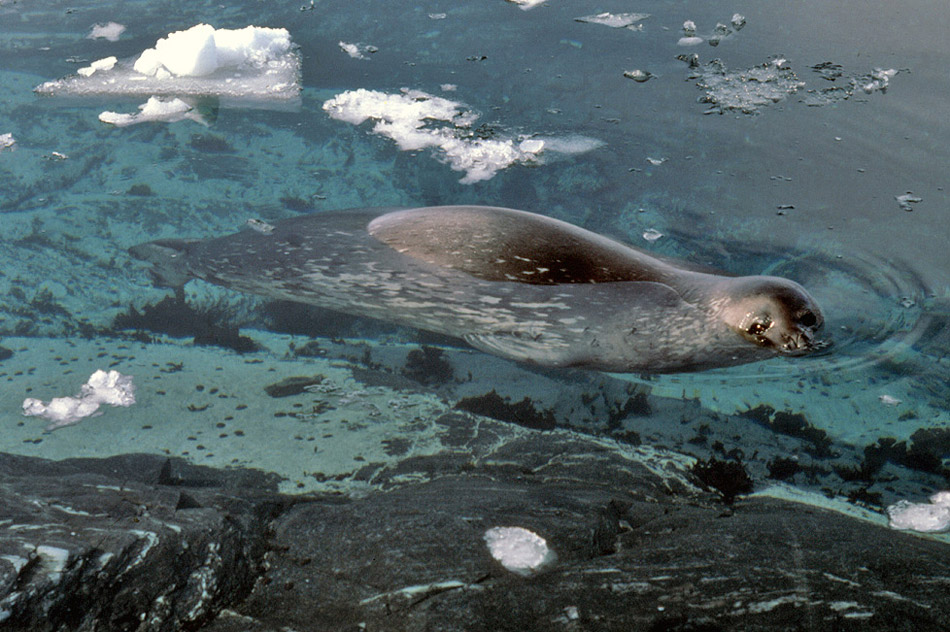
The above picture is of a juvenile Weddell seal weaned from its mother about 2 or 3 months previously and already completely in control in its aquatic environment. The scene a few months previously was rather different, Weddell seal pups don't automatically realise that they can or should dive and the early attempts are amusing to watch. "Attempts" is maybe the wrong word. What actually happens is that the mother pushes the pup into the water against its will. She then pushes its head under the water - again against its will. There is much coughing, spluttering and panic before the pup realises that it can hold its breath under the water and that this in fact does help! The pups soon get the hang of it and as adults will dive to up to 600 meters (2,000ft) or more staying under for up to an hour and going as much as 12 kilometres from the breathing hole.
Weddell seals usually have their pups on sea-ice, or land very near to sea ice, getting in and out of the sea through a breathing hole. These breathing holes are guarded and kept open by the males during the time when the females give birth.
The male guarding the hole will defend a territory beneath the ice against other males for access to mates. The females are ready to breed again shortly after the birth of the pup so the males that successfully defend a breathing hole will mate with the mother seals that use this hole, typically this will be a ratio of about 10 females to one male.
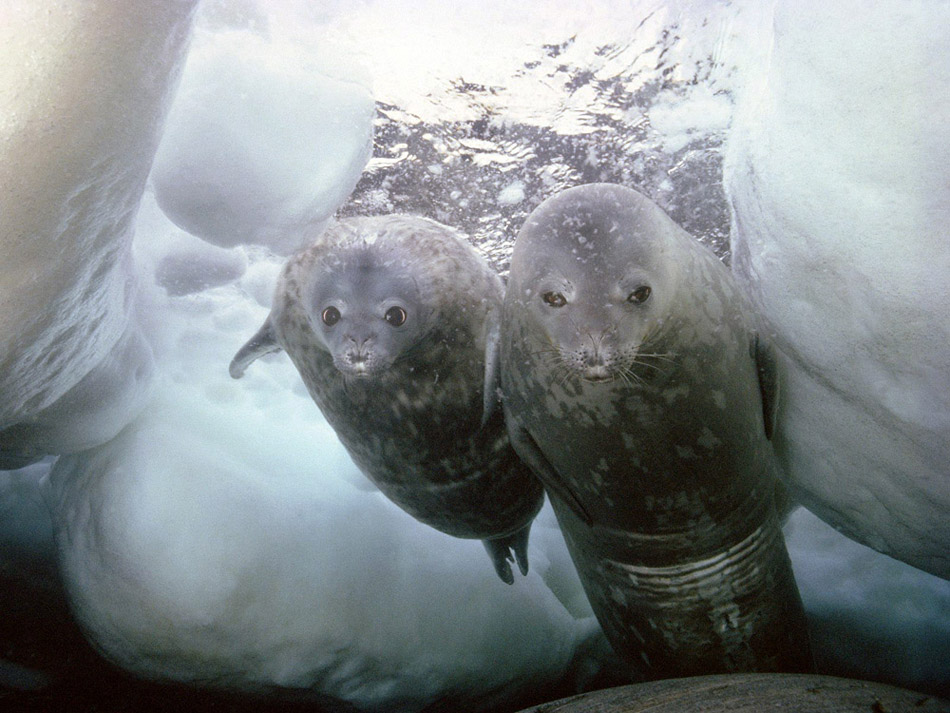
A typical feeding dive takes the seal to 200-400m depth and lasts for 5-25 minutes.
Breathing holes
Weddell seals prefer to live on ice that is broken up somewhat, in this way there are often natural cracks and holes through the ice that they can use to get in and out of the sea. There are also holes and cracks around ice bergs that are trapped in sea-ice and often "tide-cracks" appear near when near land, all of these help.
These holes are fine to begin with, but when temperatures are well below freezing, they begin to freeze up again - quickly. The seals keep the holes open by rasping them with their teeth. They open their mouths wide and move their heads from side to side in a wide arc attacking the ice that is building up around the sides of the hole. This is a very fast and vigorous process that takes a lot of energy and a toll on the seals teeth.
Keeping breathing holes open like this wears away the teeth of Weddell seals and it is this that means that the Weddells only live to about 18 years old, about half the life-span of a crabeater seal for instance.
Weddells can swim great distances across what appears to be continuous sea-ice by detecting natural cracks and holes along the way where they can surface for a breath. When covering distance rather than fishing, they only dive to a shallow depth and find the next breathing hole in the gloom under the ice by sonar - they emit a series of high pitched sounds and pick up the difference in sound when the sounds reach a hole.
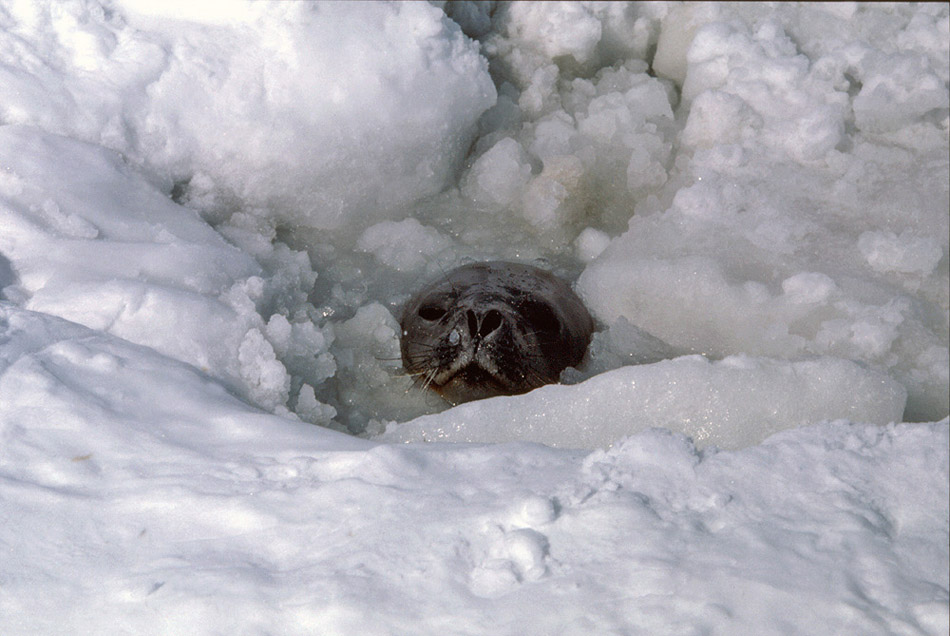
Weddell seals are very hardy, resourceful and quite remarkably behaviorally adapted for life in the Antarctic pack and fast-ice as this picture shows. Tthe seal has found a breathing hole through pieces of only partially consolidated pack-ice where there is a non-frozen portion that is nonetheless filled with slush. From below such a region will let considerably more light through than the thick pack-ice pieces and stand out like a beacon to a seal swimming by, even if it is solid, it will probably be thin enough for the seal to break through. Weddell seals have no land-based predators and so there is no danger to them of coming up to such breathing holes, just the odd surprise if there's a wandering scientist nearby to capture the moment on camera.
Why are the White Island Weddell seals special?
White Island is an Island in the Ross sea that has the most southerly population of Weddell seals. These seals are only 1300 kilometres from the South Pole, but this is not the only remarkable thing about them.
They are isolated from the rest of the world as the nearest open sea for them to is too far under the very thick ice of the Ross ice shelf for them to get out.
These seals are thought to have travelled to this area between 50 and 100 years ago when a large chunk of permanent ice shelf broke off. They were then trapped when it reformed behind them and have remained here ever since. They use cracks in the ice immediately beside White Island to reach the sea, they must dive about 70 meters here through cracks in the ice before they get down to the open sea below. In the summer when the sea ice has broken up, it is still at least 22 kilometres to the next breath at the edge of the ice shelf, too far for the seals to manage.
So here they remain unable to leave the area and with a deep dive past walls of ice before they can even begin fishing.
Weddell seal adaptations
How are Weddell seals adapted to survive in Antarctica?
The most southerly dwelling of all mammals they live at the edge of pack ice wherever there is a breathing hole or tide crack.
- Anatomical - Structures of the body.
- Behavioural - The manner in which animals move and act.
- Physiological - The internal functions of the animal from biochemical, to cellular, tissue, organ and whole organism levels.
Weddell Seal Anatomical Adaptations
Weddell Seal Behavioural Adaptations
![]() Weddell seals keep breathing holes in the ice open
by rasping back and forth with their teeth, this allows them
to live further south than any other mammal.
Weddell seals keep breathing holes in the ice open
by rasping back and forth with their teeth, this allows them
to live further south than any other mammal.
![]() They can swim large distances between breathing holes
and cracks, finding the next hole using a form of sonar
with high pitched sounds.
They can swim large distances between breathing holes
and cracks, finding the next hole using a form of sonar
with high pitched sounds.
![]() They avoid the "bends" when diving by exhaling first
and allowing the lungs and air passages to collapse so there
is no contained air that will allow nitrogen to dissolve in
the blood and cause the bends.
They avoid the "bends" when diving by exhaling first
and allowing the lungs and air passages to collapse so there
is no contained air that will allow nitrogen to dissolve in
the blood and cause the bends.
![]() Males compete for underwater territories around a breathing
hole which gives access to females using the same breathing
hole
Males compete for underwater territories around a breathing
hole which gives access to females using the same breathing
hole
![]() They flush fish out that are hiding in broken up ice by blowing
bubbles.
They flush fish out that are hiding in broken up ice by blowing
bubbles.
Weddell Seal Physiological Adaptations
Picture credit - Underwater pair of seals - changehali, used under Creative Commons 2.0 generic license.




